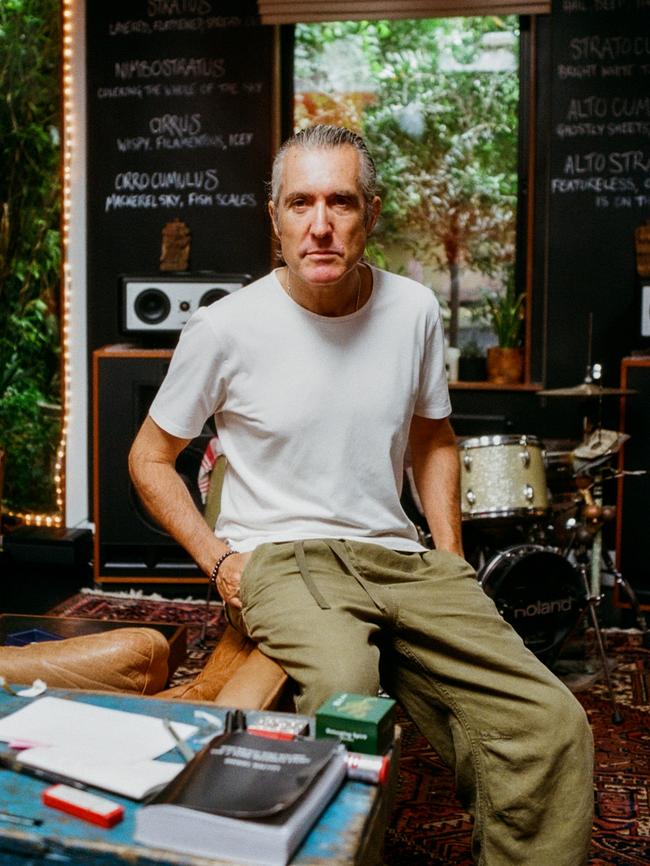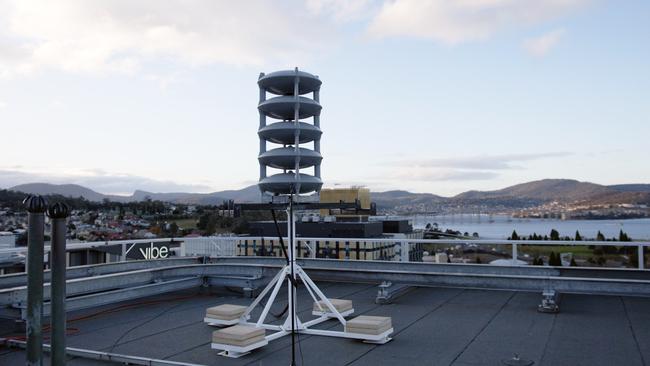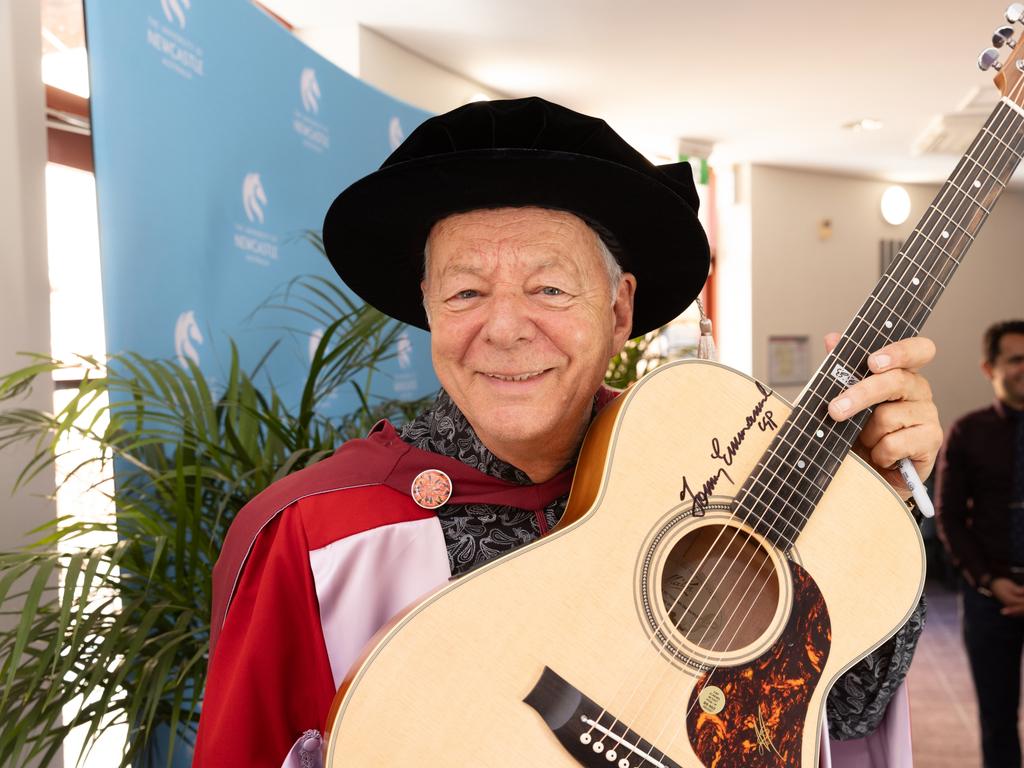An unavoidable, citywide artwork by Richard Russell marks Dark Mofo’s return to Hobart
At 6pm on the first Friday in June, the Tasmanian capital will broadcast a new musical work so far, wide and loud that it will be unavoidable for anyone within 7km of central Hobart.
Art tends to exist on a parallel path with our lives, and unless you’re seeking it out, it’s easy enough to avoid. But what if art was, for 30 minutes on a Friday evening, completely unavoidable in all directions for about 7km from the centre of a capital city?
What if you had no choice but to interact with – and therefore have an opinion on – a piece of music that’s never been heard before, before it disappears into memory?
That’s the premise behind a work commissioned for Dark Mofo, the midwinter arts festival held in the Tasmanian capital.
Established in 2013, Dark Mofo has become a bankable tourism draw and fixture of Hobart’s CBD, with scores of businesses opting to place crimson lights in their front windows in line with the red-and-black branding of what’s become one of the nation’s must-see annual events for those who thrill to the notion of experiencing surprising art together.
This time around, though, festival organisers have elected to step up their programming by powering on a mass notification system and using it for something other than its intended purpose, which is usually to inform the citizenry that something terrible has happened, or is about to happen.
“We’re the only organisation in the world that is using a system like this for art,” Dark Mofo artistic director Chris Twite tells Review. “This is normally reserved for times of emergency, and for communications in those ways. This is the way that we can turn that system to be an expression of art, which is an incredible opportunity.”
What, exactly, is the nature of this performance?
Well, very few people have heard it yet, so any guesses would be purely speculative.
But if you’re anywhere near Hobart on the evening of June 6 – and again on June 14 – it will be omnipresent, and heard well beyond the city centre.
It’s called Every Jewel Reflects Every Other Jewel, a 30-minute work performed by Everything is Recorded — a moniker adopted by British record producer and label leader Richard Russell.

That’s a mouthful, and the man himself is far from a household name, even if 54-year-old Russell is associated with some of the world’s major acts: first as an A&R (artist and repertoire) scout at XL Recordings, then as its chief executive since 1994, he’s released mega-selling albums by the likes of Adele, Radiohead, The Prodigy and The White Stripes, among many others.
As label head, he opted for quality over quantity by decreeing that XL would only release five albums per year. During the late-2010s, after recovering from the auto-immune disease Guillain-Barre syndrome, Russell began gathering musicians at his home studio to record free-form jams to mark solstices and equinoxes, which he later released for free on Bandcamp. His three albums released since 2018 as Everything Is Recorded, meanwhile, have featured guest artists such as Florence Welch, Sampha and Kamasi Washington.
But the idea to pair Russell’s musical brain with something between a wartime klaxon and a hi-tech sonic cannon – whose name, Genasys 360XL, coincidentally contains the extra-large tag of his record label – took a creative leap that feels at home amid Dark Mofo’s reputation for commissioning provocative works.

Twite joined as artistic director in 2023, before later that year announcing the two-week festival would opt out of presenting the full-scale event in 2024 during a “period of renewal”. This year marks its return, and on a call from Hobart in early May, he takes up the story of how this all came together.
“It was something that I really wanted to be part of the conversation around Dark (Mofo) from the very beginning, because we’ve had works like Spectra in the past: this beautiful, shining light (pillar) that Hobartians and visitors could step outside of their hotel and see from a distance, and they know they’re in the festival as soon as they leave their house,” says Twite, 43, referring to a work by Ryoji Ikeda first installed in 2013.
“This work is the audio equivalent of that: they can come out on to their front doorstep and be part of the festival immediately; they can see art in the street before they even wander further into town. Art on this scale, for kilometres, is something that no other city can do; it’s an amazing ability that Hobart has, and we’re so lucky to be able to do that here.”
The Genasys 360XL was first used two years ago in Dark Mofo’s program, when a performance by German-British composer Max Richter named Voices was beamed far and wide, beyond the inside of a concert hall where the Tasmanian Symphony Orchestra was playing Richter’s music.

Twite has his own history in sound works presented for the likes of Sydney Festival. “I’m always interested in ways we can step those things up and elevate those works to make them even bigger. The first week I got here, I found out about the system, and I was like, ‘Oh, wow – this is big!’ ” he says with a laugh.
“I thought we can make something really special that’s just for this moment, and just for Hobart. We set about trying to think about collaborators that we could work with to achieve that, and of course Richard, in everything that he’s done, is perfect for something like this. His works around the solstice, the equinox – to be able to turn to someone and say, ‘You’ve already been investigating this. What if we gave you the platform to speak to an entire city about a solstice? What would you create? Who would you bring in?’ ”
Russell’s response, in Twite’s telling, was swift and straightforward. “Yeah, I’m on board,” replied the Brit.
Says Twite: “Richard’s project, Everything Is Recorded, pulls in all of these different performers who are in London to say, ‘Come to my studio and we’ll make this work.’ Those works are beautiful moments of a singular point in time that can’t really be repeated, because all of those people are never in the same space again. So to be able to capture that one moment with this one vision around, ‘How do we talk about the winter solstice?’ ”
The notion of commandeering an existing, if underused technological system to present a new artwork is clearly one that delights the Dark Mofo director.
Of the Genasys 360XL, says Twite: “Without getting too ‘boffiny’ and in the weeds, it’s an omnidirectional sound projection, so it goes out in all directions at once, and the sound reflects off different surfaces, so you’ll hear it at different volumes, depending on what surfaces you’re near. It projects for about 7km in every direction around the city, so you should be able to hear it in almost all of Hobart.”
“In terms of where it’s used elsewhere, think about it as an emergency beacon for an evacuation. Elsewhere, it’s reserved for emergency services, or for times of panic, or times of concern. So it’s really just changing the narrative of what that tool is used for; to turn that instrument of the state into something that can be used for an incredibly beautiful moment.”
In all states and territories, a standardised siren sound known as the Standard Emergency Warning System, or SEWS, has been used since 1995 to deliver urgent safety messages to the public in the event of disaster or emergency. As well, there’s a national telephone warning system known as Emergency Alert, which is used by emergency services to send text messages to mobiles and voice messages to landlines to warn of fires, floods and the like. Since 2009, it has issued about 70 million messages on 2250 separate occasions.
A new National Messaging System is being built, and is expected to be operational in mid 2027. (Cell-broadcast technology is now considered international best practice for emergency warnings; it has been adopted by more than 20 countries.)
As for the regulatory aspects of taking over a citywide broadcast system for two half-hourly, art-centric occasions next month, Twite is a little more tight-lipped.
“There’s definitely technical requirements that we work with the government to allow us to do those, and we work very closely with the government departments and the City of Hobart to make sure that we meet those regulations,” he says. “It’s an ongoing process, but they’re very supportive of it, because it’s such a uniquely Hobart moment.”
Russell’s musical work with his collaborators won’t be performed live in Hobart; instead, it will be delivered remotely, as the recording itself was captured on April 17 at his West London studio, dubbed The Copper House, which is a five-minute walk from the XL Recordings office.
“I had heard about this event in Tasmania from a visual artist friend,” Russell tells Review via email. “I’d love to visit and participate in person one day, but getting the opportunity to compose and perform a piece specifically for Dark Mofo in my own studio in London, with none of the environmental or personal stress of travel, was great. We could completely concentrate on the music with none of the other aspects you normally have to consider when travelling and performing.”
When it came to the recording session, “I chose five other musicians I love working with: Roses Gabor, Laura Groves, Clari FT from Mary in the Junkyard, Yazz Ahmed and Tic,” says Russell.
“We set up downstairs in my studio. We blew up photos of Hobart and put them on the wall. We checked our equipment. And then we improvised for four hours. No discussion, no theory. Responding to each other and to the images on the wall. Just feeling. I spent the next week with Oli Bayston editing the work and structuring a half-hour piece.”

As for testing the Genasys 360XL ahead of Russell’s first airing on the klaxon, as it were? “We don’t really talk about processes around the testing in public forums,” says Twite.
In the program, this work is placed alongside an Oscar Wilde quote: “The suspense is terrible. I hope it will last.” What might it sound like, and how might it might make you feel? Well, you’ll just have to be there.
“These things are ethereal and temporal,” says Twite. “After the sound is over, it’s gone, and if you weren’t there, you won’t understand what it was, and you’ll never be able to fully communicate to someone what all of the parts of it that you heard were.”
Asked how he hopes the work will be received in the streets of Hobart, Russell replies: “Ideally I’d like people to listen in the same spirit we played. Which was relaxed but attentive. Phones off. Breathing. Meditative, but also moving and being aware of the people and the space around you. And maybe some people might have some of their own creative ideas while they listen. I’d love that. That can happen if you clear your mind.”
Everything Is Recorded: Every Jewel Reflects Every Other Jewel will be broadcast citywide in Hobart on June 6 (8pm) and June 14 (6pm) during Dark Mofo.





To join the conversation, please log in. Don't have an account? Register
Join the conversation, you are commenting as Logout